IT’S BEEN A FEW days since Tet, Vietnam’s riotous weeklong New Year holiday, but Sapa is still in celebration mode. “There’s a festival tomorrow in Cat Cat village… you should go!” says my guide, Khu, a 20-something rice farmer from nearby Lao Chau. Khu is leading me through Matra, a Black Hmong hilltribe village five kilometers away from Sapa city, and its glut of tourists who come to hike the region’s famed rice terraces. Guiding is Khu’s main source of income now that harvest season is over and the northern Vietnamese winter has turned much of Sapa’s iconic green fields into cascades of dirt and mud.
With farm work on hold, the locals are happy for a distraction from strangers. As we trudge past empty fields, I hear calls of “Hello!” from inside a corrugated tin shack, where a merry group of guys offers us swigs of homemade rice wine from a recycled soft-drink bottle. My polite declines are useless against their insistent laughs, so I shrug and take a gulp. It’s Tet, after all. The wine is potent and full of funk, but goes down velvety and warm. “Some people call it alcohol,” Khu says. “We call it happy water.” Yep, the party is still on in Sapa.
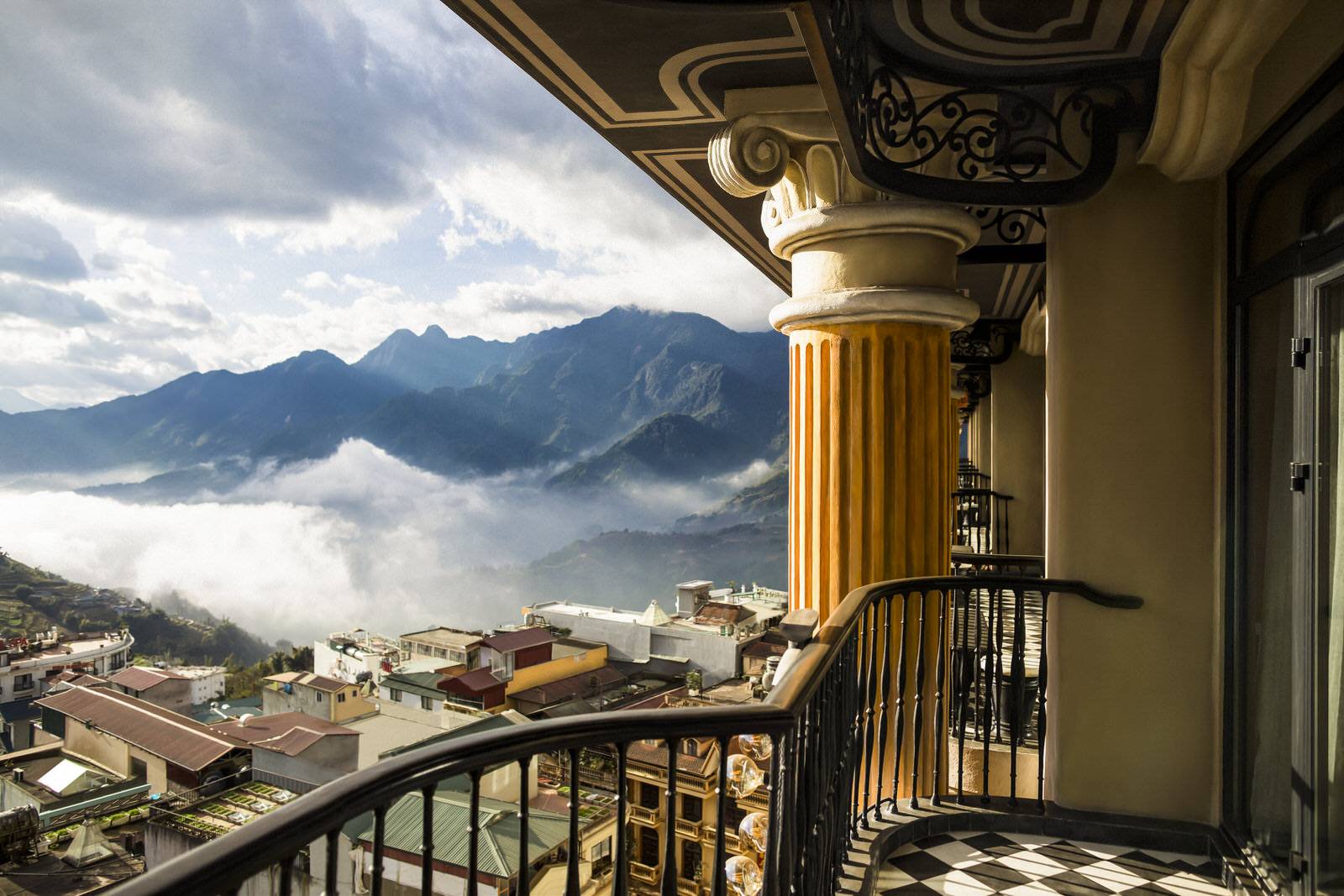
Hotel de la Coupole among the hills of Sapa.
Though the Google Images version of the region—lemon-lime rice-paddies rolling across hills like silk—was sadly out of season, one bush grows year-round in Matra: the indigo plant, a defining part of the Black Hmong tribe. It steeps in deep, navy-tinted vats outside most villagers’ homes, and gives their traditional outfits that signature inky-blue hue. Khu spots a few stems growing on the side of the road and crushes the leaves into my hands with a splash of water. I rub them together as she instructs, and my hands stain a Kermit green. As the dye dries, it deepens to a light indigo. Khu points at her midnight-blue skirt, framed with neon-pink embroidery, the traditional dress of the Black Hmong people: “It takes one year of drying for it to become this dark.”
The textile culture in Sapa, a five-hour drive northwest of Hanoi, is a strong part of what distinguishes the many ethnic minorities that live here—the scarlet headdresses of the Red Dao, the rainbow weaves of the Flower Hmong. Each tribe’s individual craft has been passed from generation to generation, and now they are embodied in a grand new space in the center of town. The Hotel de la Coupole, the first international five-star in Sapa, takes this rich tradition and runs with it; both hilltribe fabrics and French haute-couture inspired the hotel’s aesthetics, a Wes Anderson–style vision dreamed up by prolific hotel designer Bill Bensley.
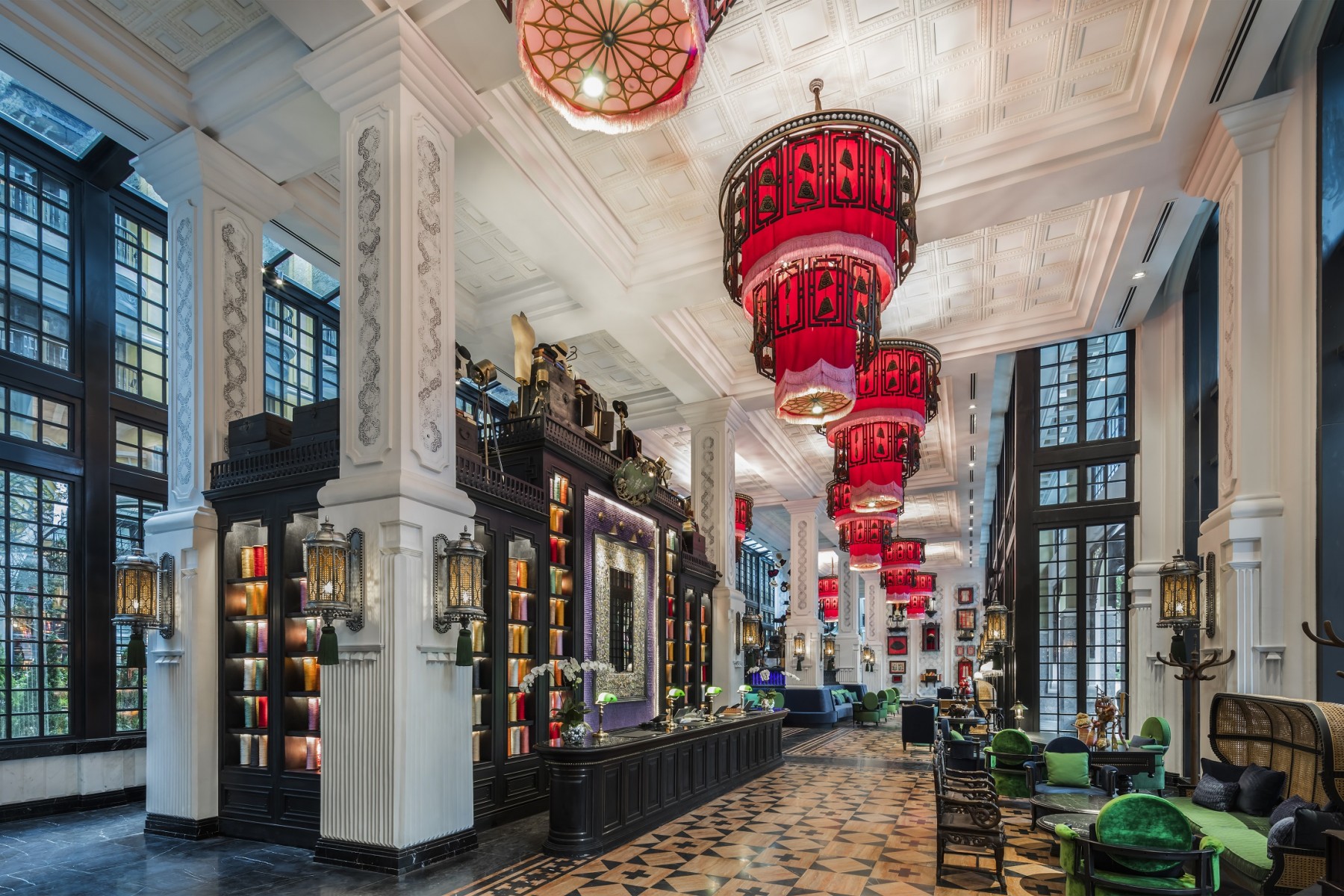
Hilltribe meets haute-couture at Sapa retreat Hotel de la Coupole.
This stylish ode to Sapa’s heritage is my first stop on a north-to-south tour of Vietnam that takes in three of its historic destinations: Sapa near the Chinese border, Quy Nhon in the center, and Con Dao off the Mekong Delta; one overrun with tourists, one virtually unknown, and the other infamous. As each destination gets a lavish new abode for visitors to play in, their draw is expanding beyond just historical appeal. But, for these properties, the heritage that precedes them is inherent to the high-end experience. For me, a first-time visitor to these parts, I’m happy to learn the past is still sticking around.
AT HOTEL DE LA COUPOLE, I spot reminders from my walk in Matra everywhere I go. Indigo batiks cloak elevator walls, upholstery and pillows; lampshades resemble the tribe’s structured headwear and silver jewelry. Like many of Bensley’s over-the-top interiors, a stay here is like a night at the museum—the Bangkok-based designer spent five years collecting antiques from Parisian flea markets to represent the French haute-couture concept, a nod to the wealthy colonialists who used Sapa as a hilltop retreat at the turn of the last century. The lobby alone makes me gawk: 500 oversized vintage spools handspun with hilltribe threads back the concierge, and a stack of old French suitcases (including a Louis Vuitton number) are piled above.

Con Son town.
I meet up with General Manager Jean-Pierre Joncas, who tells me I actually just missed Bensley; he had dropped off another 750 kilograms of antiques from Paris just before I arrived. “Every month he brings more things and keeps adding to it,” he says. I ask him when they’ll be done and he pauses for a second, then laughs, “I think if we waited for him to finish, it would be another five years before we could open.”
The hotel’s 249 rooms rise straight into Sapa’s perpetual cloud cover, complementing the moody design and the eponymous glass domed rooftops with a constant misty setting. During clear moments, the balcony from my emerald-painted Deluxe room frames vistas of Fansipan mountain, the highest peak on the Indochinese Peninsula, which I can, in fact, reach right from the lobby. The hotel shares space in a mixed-use building owned by Vietnamese development company Sun Group, so is just steps away from the train station to their groundbreaking cable car.
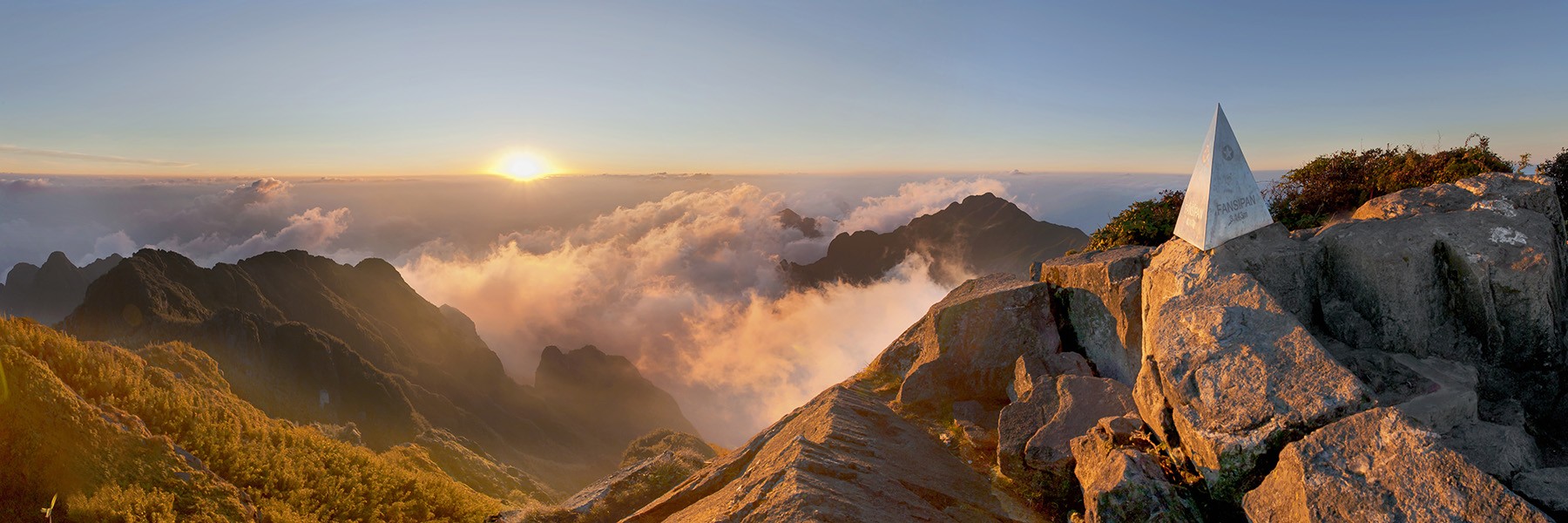
The view from the top of Fansipan mountain.
When it opened in 2017, the Fansipan cable car was the world’s longest at 6,292 meters, and made Sapa’s highest peaks more accessible for non-trekkers. The cable car glides over terraced valleys, swaying bamboo forests and cliff-side waterfalls, but Fansipan’s beauty peaks with its height. When we land, the mountaintop is swallowed in clouds. But as the bitter wind pushes the mist away, red-tiled temples, an effigy of Guan Yin the goddess of mercy, a gleaming golden Buddha, and all of Sapa below come into view. On the way back down on the train, I can even see the crowd gathering for the party in Cat Cat, and I give a vain wave to Khu from up above.
At dinner under the cupola at the hotel’s restaurant, Chic, executive chef Basha Shalik serves dishes inspired from both Sapa and the French: my sturgeon hotpot comes with a bouillabaisse broth; a creamy mushroom soup uses only wild fungi from Sapa’s forests; pear tartine uses the pho spices of cinnamon, star anise and clove. For better or worse, Sapa has grown up. Though its small-town charm may be lost with the influx of tourists, here its legacy is still proudly on show.
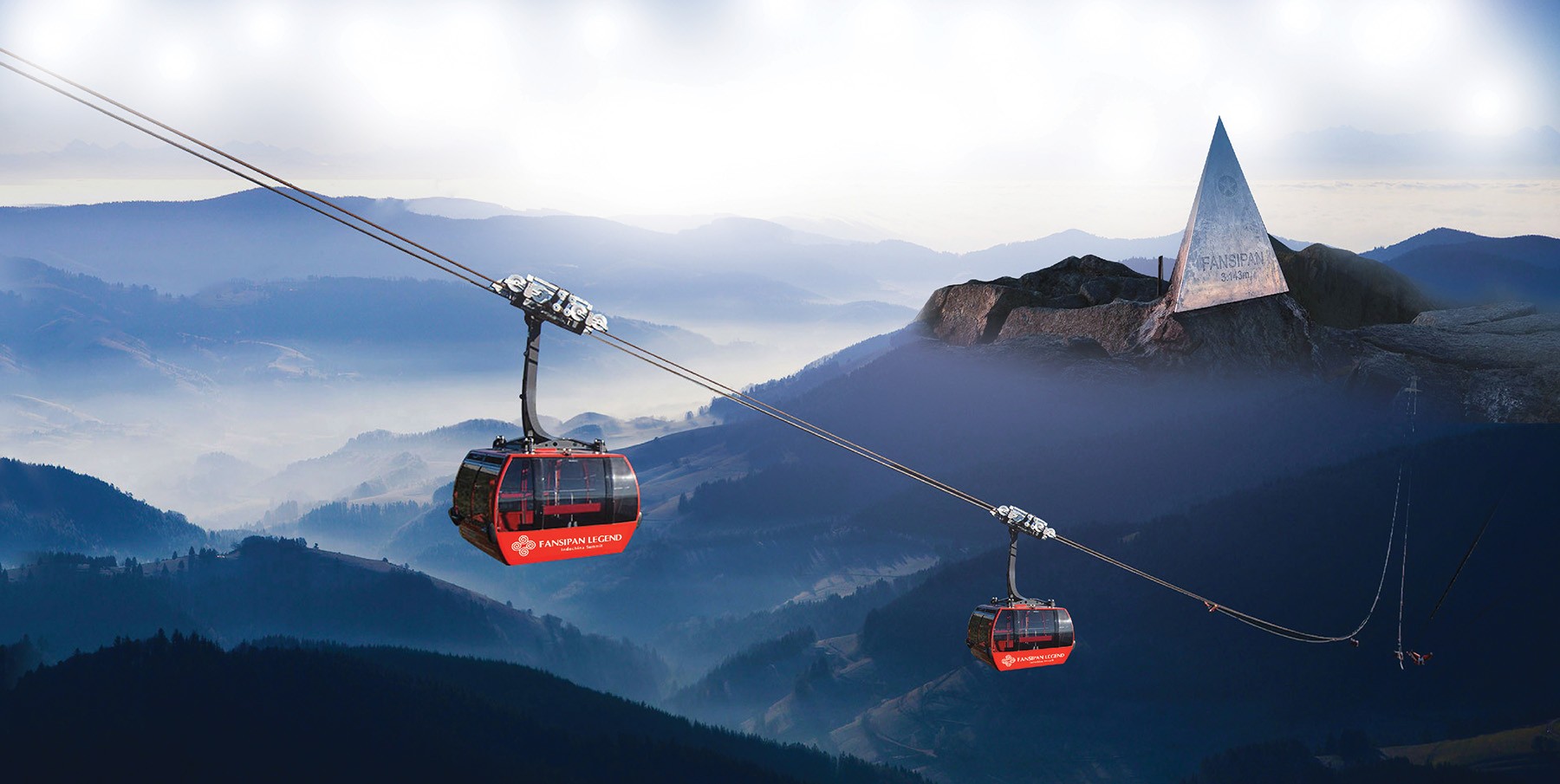
Into the mist on the Fansipan cable car.
BY THE TIME I, arrive in Quy Nhon, a seaside city 300 kilometers south of tourism hotspot Hoi An, night has fallen. It’s too dark to see how pretty my new digs are at The Anantara here, but the bay’s carpet of twinkling lights puts on an evening show just steps from my beachfront villa deck. Like a mirror for the stars, the sweep of ocean shines with lights from hundreds of floating squid traps; Quy Nhon is famous for its seafood, and I’ve been dreaming about it all the way from Sapa.
Daylight casts a finer picture of just how special this place is. The all-villa resort is the first of its kind not just for the Anantara brand, but also for the location. Though it was an important staging area for the U.S. military during the war, Quy Nhon is several hours off the beaten track from its world-famous beach neighbors Da Nang and Nha Trang. It may seem an odd choice for an international five-star, but for Anantara, with sister brand Avani already owning the property next door, it just made sense. “We had this stretch of land, but Anantara also likes to look for unusual destinations,” director of public relations Kate Jones tells me over dinner at the resort’s grill-focused restaurant, Sea Fire Salt. “People don’t want to see what everyone else has seen before; they want something new.” But there’s also no reason Quy Nhon shouldn’t be on travelers’ bucket lists—golden sand fronts wavy blue ocean and nearby uninhabited islands, the forested hills offer virgin trekking, and ancient towers provide a peek at Vietnam’s former Champa reign.

Private infinity pools are a highlight of every Anantara Quy Nhon villa.
Central Vietnam was the base of the Champa kingdom, which also covered parts of Cambodia and Laos, during the 11th to 15th centuries. Quy Nhon’s port, Thi Nai, was an important point of trade for the empire with China, Southeast Asia and beyond. After the Vietnamese conquered the Champa people in 1471, the port town remained active, and later became a strategic military base for the Americans during the war. This history and a look at local life is weaved into every Anantara guest’s stay—when I met with Kate, she was just finalizing a fishing tour where guests set out in traditional basket boats. I get a dose on the Quy Nhon Explorer experience, guided by Huy, a local to the region and also the hotel’s guest relations manager. We visit the Banh It Champa towers that sprout up on a hill from the region’s flat farmlands. The skinny, burnt orange–brick towers were built by the people around the 11th century as a place to worship their gods and ancestors, and to pray for protection from droughts and floods. Inside the tallest tower, Huy tells me not to mind the bats screeching above us in the triangular-roof’s abyss or the scribble of graffiti on the walls—the scrawled devotion of local lovers over the years—and instead lights me an incense stick, points at the statue of Shiva and tells me to make a wish.
We also visit the sprawling Tien Hung pagoda, still bustling with Tet revelers, and the dilapidated remnants of Quy Nhon’s former leper colony—a still functioning hospital and peaceful memorial on a quiet stretch of Quy Hoa Beach. Though this history is fascinating, my favorite part of the tour is just watching everyday life roll out. We visit a small incense factory, where a score of women swathe thousands of bamboo sticks in a fragrant cinnamon coating, then lay bundles to dry beneath the hot sun. We order a drip coffee from Huy’s favorite café, and watch the world go by.
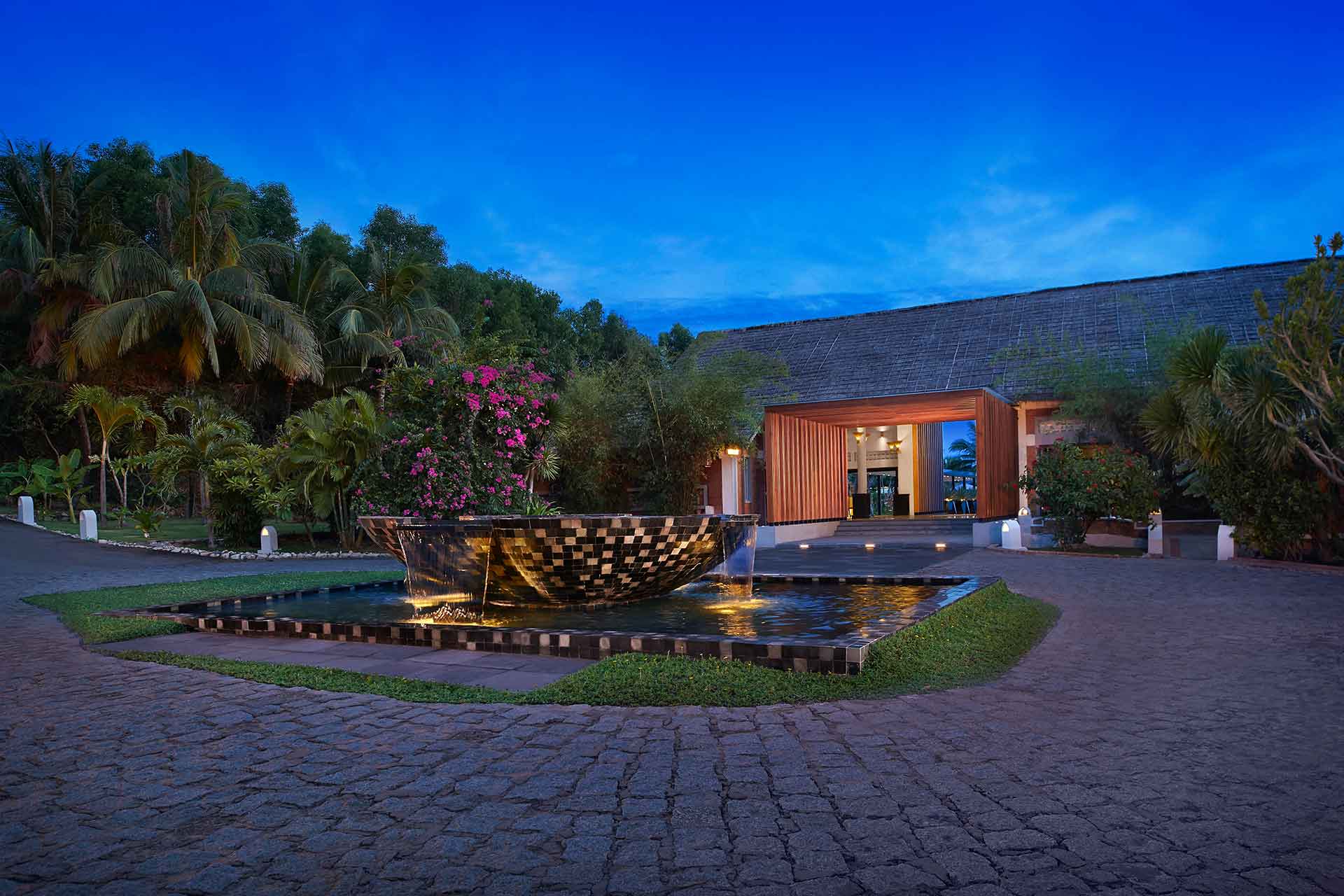
Entrance to Avani Quy Nhon.
At lunch I get my seafood fix at local joint Anh Vu Tom Ngai, famous for Quy Nhon–style banh xeo topped with tom ngai, jumping shrimp. Here in Central Vietnam, the rice-milk crepes are plain white without the yellow addition of turmeric. They’re also smaller than most of the versions I’d eaten elsewhere in Vietnam, cooked in a disc-sized pan that’s overflowing with so much bubbling oil it catches on fire, searing the cakes with a lick of char. I layer my banh xeo with a bouquet of herbs and slivers of green mango, roll up the crisp pancakes in delicate rice paper, then dunk them in the pineapple-spiked fish sauce—the condiment of choice here in Quy Nhon. One bite in and I tell Huy we’re going to need another helping.
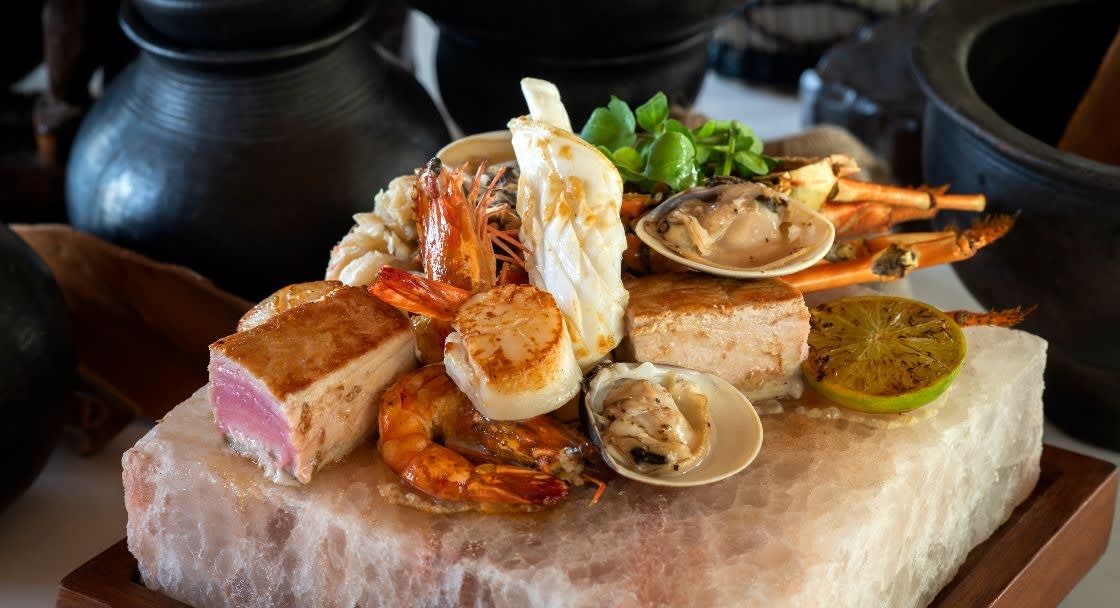
Seafood from Sea Fire Salt.
I spend the rest of my visit swanning around my villa, taking advantage of my wine cellar, and mini bar stocked with deli cheeses and cured meats, and cooling off with dips in my private pool. One lunchtime, Sea Fire Salt’s executive chef Thu teaches me how to make banh xeo, though I’m not as liberal with the lashings of oil that made Anh Vu’s so addictive. Another morning, Anantara’s head of security, Phuc, gives us a beachside lesson in the local martial art Viet Vo Dao, of which he’s Quy Nhon’s master. Surprisingly, I’m more coordinated than I thought I’d be, and the swift flow of movements sends a bolt of strength through my body. This string of villas may have opened up Quy Nhon as a new luxury destination off Vietnam’s well-trod path, but here, it seems, I don’t have to worry about the local culture slipping away because of it.
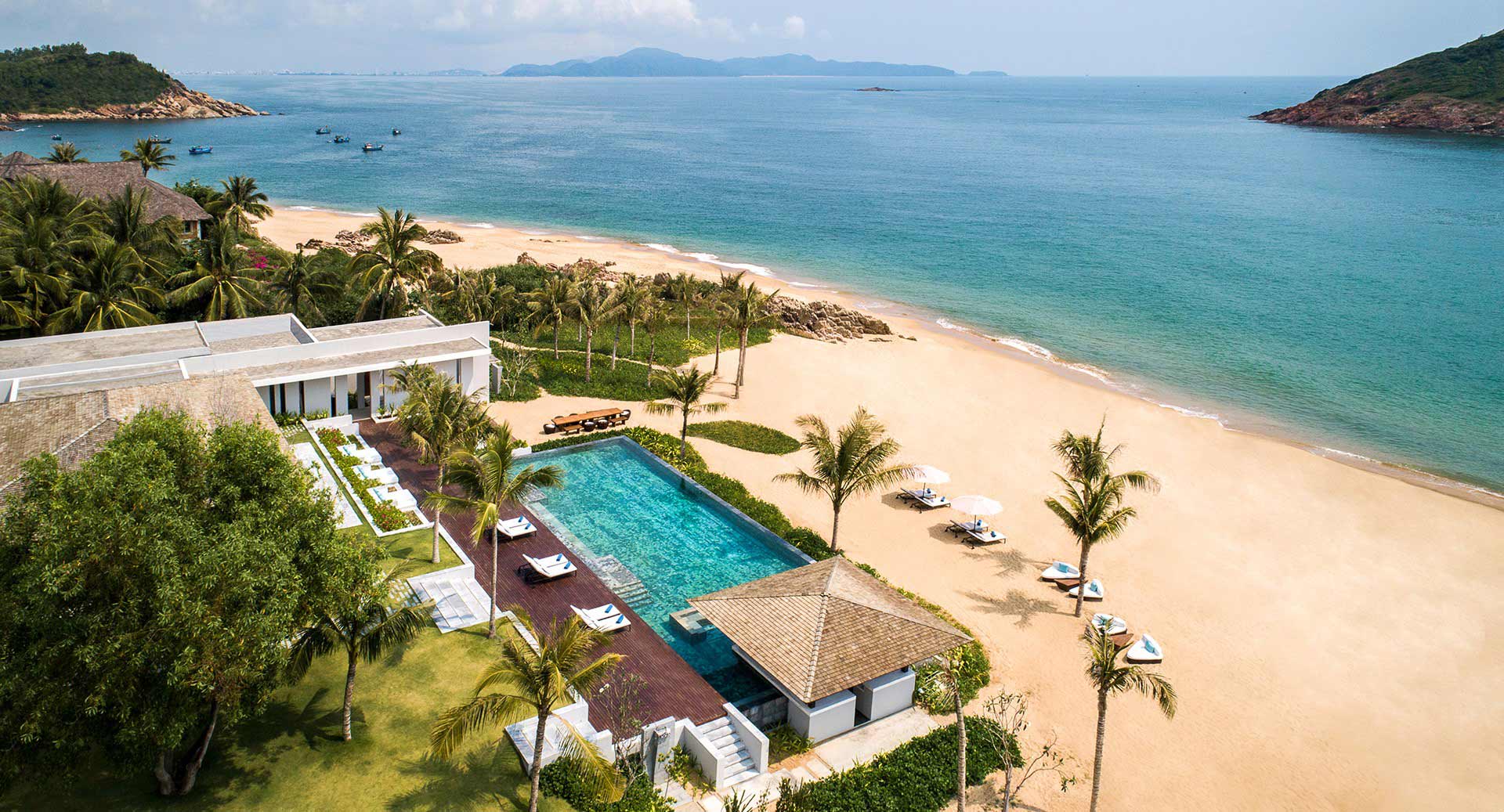
Anantara’s beach
IT’S MY FIRST day of island life on Con Dao, but I can’t stop blinking away tears. This southern archipelago just a scenic 45-minute prop-plane flight from Saigon has everything you pine for in paradise—jade-green jungle hills crown empty crests of sugar-white sand that give way to the bluest oceans and even a baby turtle or 200—but the sting of the island’s dark past is sobering.
For more than a century until 1975, Con Son, the largest island of the group, was a prison complex rife with inhumanity—violent beatings, unthinkable torture and countless executions. It started with the French, who were ceded the island during the Versailles Treaty in 1861 and used the prison to house thousands of political dissidents, including Vietnamese Nationalist Phan Chau Trinh, an early resister of the French occupation. When the Americans arrived, they transferred the prisons to the South Vietnamese to hold communists and Viet Cong, as well as students, writers and other opposing voices. “There are 8,000 people living on this island, but there are more than 20,000 spirits,” says Huong Bach, the assistant resort manager at Poulo Condor Boutique Resort & Spa, about those who died in the 113 years of Con Dao’s history of incarceration.

The cottages at Poulo Condor feel like French colonial homes.
Over the past generation, Con Dao has transformed its image, becoming a lush escape for Saigon holidaymakers, with a Six Senses staking claim in 2009 as the luxury resort of choice for most expats and in-the-know tourists. Since it opened in 2017, Poulo Condor offers this same contemporary high-end service with a heritage slant. Taking the French name of the island, the resort arranges its 36 suites and villas like a quaint colonial village, with signposted streets—Rue de Tourane, Rue de Cochin and Rue de Tonkin—leading guests to white- washed cottages, a lake carpeted in flamingo-pink lotus flowers, an infinity pool with a mountain backdrop, and, out front, that sapphire South China Sea shoreline lapping at kilometers of empty, surprisingly deck-chairless, soft, white sand.
Today, this natural beauty is eclipsing Con Dao’s scars, offering access to some of the country’s best marine life. Neighboring Bay Canh Island is a day-tripper’s dream, covered in protected rainforest and edged with vibrant reefs where snorkelers and divers of all levels can spot manta rays, dolphins, a possible whale shark, and, of course, the archipelago’s famous green sea turtles, who lay their eggs across the islands from May to October.

The beach at Six Senses.
After a refreshing dip in the resort’s strip of Vong Beach, I spend the rest of the afternoon exploring the 30-hectare jungle property by bike, kayaking along the in-resort stream, and ending the day with a blissful few hours in the lake-view spa where I try my first-ever cupping session. In my Colonial suite, a spacious one-bedroom furnished with wooden antiques and European art, plus a full bath and outdoor rain shower, it’s easy to lose yourself in the romanticism of the French era. But the island’s past is not disconnected here, rather, it’s intrinsic: the owner, Le Ngoc Tu, was a prisoner on Con Dao, serving three years of a 20-year sentence. Along with his daughter, Le Ngoc Quynh, who decorated the resort’s interiors with antiques she handpicked from Saigon’s vintage stores, the pair opened Poulo Condor as a tribute. “[My father] wanted to give thanks to the island,” Quynh says. “He was still alive after the war, but some of his friends passed away while serving their sentences.”
Huong has organized the prison tour for me with guide Van, who gives vivid recounts of how shackles chained to an iron bar bound all the inmates together inside the island’s most well-preserved prison, Phu Hai. Van tells me the legendary story of teenage heroine Vo Thi Sau, who became a guerilla fighter for the Viet Minh in 1948, and even managed to lob a few grenades at the French before she was executed at Phu Hai at the age of 19. Today, she’s an icon and has her own shrine where worshippers, mostly from the north, come to offer her expensive jewelry, makeup, designer handbags and fancy dresses in exchange for prayers and blessings. Vo Thi Sau has pride of place at the Con Dao cemetery, where most other graves remain nameless, and Van tells me that the few who have tried to destroy her headstone have all been mysteriously haunted to their untimely deaths.
It’s at the French Tiger Cages where I break. Surrounded by a larger fortress, the block of 70 pantry-sized cells for more than 500 prisoners was hidden from outsiders, and only discovered after a group of imprisoned students was released and drew a map for U.S. congressional aide to Saigon Tom Harkin to investigate. I walk above the cages with open, barred tops, designed so guards could jab the prisoners with sticks to keep them awake, or throw dirty water on them during cold nights. Next door, in the solariums—roofless outdoor cells— posed mannequins curled up in pain help visitors envisage the real prisoners burned to their flesh from sitting under the sun for days on end. It’s not somewhere I feel I can linger for very long, but as I walk to the exit and notice a woman sitting on the ground softly singing, I pause. Van says she’s chanting a Buddhist hymn, a blessing for the former prisoners. The tears roll.

Six Senses’ Ocean Front 3 Bedroom Pool Villa
On my last day I hire a motorbike and cruise around the cliffs of the island for a dose of current island life. In the breaking dawn, locals crowd the main pier to buy fresh seafood direct from the fishermen’s boats; at the morning market, vendors hawk tropical fruits, a rainbow of Vietnamese desserts, and crusty banh mi. For lunch I drop by Huong’s family restaurant that sells authentic Con Dao–style bun rieu cua, a tomato noodle soup that her relatives start making at 2 a.m., catching fresh blue crabs and pounding the meat to make the moreish paste topping.

Night market in Con Son’s main town.
In the afternoon, I ride to secret beaches tucked behind dense forests all over the island—to the south, where aquamarine coves are flanked by a tangle of mangroves and fishermen nap in their rainbow-striped wooden junks; and to the cliffs above the rocky coast of Nhat Beach, where it’s said dugongs hang out in the bay. As the sun sets, I join a crowd at the small, sandy beach that flanks the pier; most wade into the sea fully clothed. Con Dao’s history is a sad one, and it’s clear no one’s forgotten it. But right here, with golden hour casting a glow over the ocean filled with everyone from old grannies to floatie-armed toddlers, the spirits are still high.
Getting There
I started my journey in Hanoi, from which you can take a sleeper train (eight hours) to Lao Cai, then a 45-minute van or taxi to Sapa town. Instead, I took a five-hour, disco-lit night bus, which brought me direct from Hanoi’s airport to central Sapa. Note: despite lay-flat beds, the ride was fairly sleepless. An airport in Sapa has been proposed for 2020.
For Quy Nhon, Phu Cat airport is 45 minutes away and can be reached with a direct flight from Hanoi (or Saigon). Con Dao is a short flight from Saigon or Can Tho. Individual hotels can book transfers, or just ask your travel agent to arrange the entire journey.
Most nationalities outside of ASEAN will need to apply for a visa before traveling; check evisa.xuatnhapcanh.gov.vn.
– by Eloise Basuki
Hotels
Anantara Quy Nhon Villas The beachfront villas are a complete treat; even the bath and shower boast floor-to- ceiling beach views. Each villa has an in-room wine cellar, deli fridge and private pool. Don’t miss a treatment in the peaceful treetop spa the property shares with Avani. anantara.com; doubles from US$500.
Avani Quy Nhon Each of the 63 rooms in this refurbished hotel has a private balcony, and loft studios are perfect for family getaways. Avani guests have access to Anantara’s main pool during low season, and can book into Sea Fire Salt year-round. avanihotels.com; doubles from US$150.
Hotel de la Coupole A wonderland of creativity and historical design, this Bill Bensley hotel marks a new standard for Sapa. The indoor heated pool looks like it’s straight out of the Gatsby mansion, with jewel-tone tiles, 20s-era girls in murals, four-poster loungers, and huge bronze statues about to dive into the blue. hoteldelacoupole.com; doubles from VND2,400,000.
Poulo Condor Boutique Resort & Spa Privacy and serenity abound in this family-run jungle retreat just 10 minutes from the airport. Villas start from 107 square meters, while two-bedroom pool villas are spacious enough for families and groups, with private beach access. Guests have free use of bicycles and kayaks, and yoga can be arranged on some mornings. Don’t leave without booking in a massage with delightful spa manager Chi. poulocondorresort.com; doubles from US$170.
Six Senses Con Dao This 10-year-old property features slick wooden “shack” villas with incredible views of their pretty much private, eternally shallow, beach. Recent additions are a speedy dive boat and an incubation center for their own clutch of green sea-turtle eggs. sixsenses.com; doubles from US$680.

